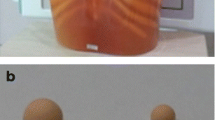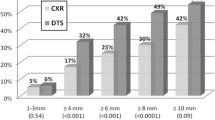Abstract
Purpose
To compare the lung nodules’ detection of digital tomosynthesis (DTS) and computed tomography (CT) in the context of the SOS (Studio OSservazionale) prospective screening program for lung cancer detection.
Materials and methods
One hundred and thirty-two of the 1843 subjects enrolled in the SOS study underwent CT because non-calcified nodules with diameters larger than 5 mm and/or multiple nodules were present in DTS. Two expert radiologists reviewed the exams classifying the nodules based on their radiological appearance and their dimension. LUNG-RADS classification was applied to compare receiver operator characteristics curve between CT and DTS with respect to final diagnosis. CT was used as gold standard.
Results
DTS and CT detected 208 and 179 nodules in the 132 subjects, respectively. Of these 208 nodules, 189 (91%) were solid, partially solid, and ground glass opacity. CT confirmed 140/189 (74%) of these nodules but found 4 nodules that were not detected by DTS. DTS and CT were concordant in 62% of the cases applying the 5-point LUNG-RADS scale. The concordance rose to 86% on a suspicious/non-suspicious binary scale. The areas under the curve in receiver operator characteristics were 0.89 (95% CI 0.83–0.94) and 0.80 (95% CI 0.72–0.89) for CT and DTS, respectively. The mean effective dose was 0.09 ± 0.04 mSv for DTS and 4.90 ± 1.20 mSv for CT.
Conclusions
The use of a common classification for nodule detection in DTS and CT helps in comparing the two technologies. DTS detected and correctly classified 74% of the nodules seen by CT but lost 4 nodules identified by CT. Concordance between DTS and CT rose to 86% of the nodules when considering LUNG-RADS on a binary scale.



Similar content being viewed by others
References
Global Burden of Disease Cancer Collaboration (2016) Global, regional, and national cancer incidence, mortality, years of life lost, years lived with disability, and disability- adjusted life-years for 32 Cancer Groups, 1990 to 2015 A systematic analysis for the global burden of disease study. JAMA Oncol. doi:10.1001/jamaoncol.2016.5688
Aberle DR, Adams AM, Berg CD et al (2011) Reduced lung-cancer mortality with low-dose computed tomographic screening. N Engl J Med 365:395–409
Jung H, Chung M, Koo J (2011) Digital tomosynthesis of the chest: utility for detection of lung metastasis in patients with colorectal cancer. Clin Radiol. doi:10.1016/j.crad.2011.08.017
Goldstraw P, Crowley J, Chansky K et al (2007) The IASLC Lung Cancer Staging Project: proposals for the revision of the TNM stage groupings in the forthcoming (seventh) edition of the TNM Classification of malignant tumours. J Thorac Oncol 2:706–714. doi:10.1097/JTO.0b013e31812f3c1a
Veronesi G, Bellomi M, Scanagatta P et al (2008) Difficulties encountered managing nodules detected during a computed tomography lung cancer screening program. J Thorac Cardiovasc Surg 136:611–617
Veronesi G, Bellomi M, Mulshine JL et al (2008) Lung cancer screening with low-dose computed tomography: a non-invasive diagnostic protocol for baseline lung nodules. Lung Cancer Amst Neth 61:340–349
Jacobson FL, Austin JHM, Field JK et al (2012) Development of The American Association for Thoracic Surgery guidelines for low-dose computed tomography scans to screen for lung cancer in North America: recommendations of The American Association for thoracic surgery task force for lung cancer screenin. J Thorac Cardiovasc Surg 144:25–32. doi:10.1016/j.jtcvs.2012.05.059
Mcloud TC (2014) Lung cancer screening: current status. Radiol Med (Torino) 119:1–3. doi:10.1007/s11547-013-0313-8
Larke FJ, Kruger RL, Cagnon CH et al (2011) Estimated radiation dose associated with low-dose chest ct of average-size participants in the national lung screening trial. Am J Roentgenol 197:1165–1169. doi:10.2214/AJR.11.6533
Mascalchi M, Mazzoni LN, Falchini M et al (2012) Dose exposure in the ITALUNG trial of lung cancer screening with low-dose CT. Br J Radiol 85:1134–1139. doi:10.1259/bjr/20711289
Båth M, Svalkvist A, von Wrangel A et al (2010) Effective dose to patients from chest examinations with tomosynthesis. Radiat Prot Dosim 139:153–158
Sabol JMJ (2009) A Monte Carlo estimation of effective dose in chest tomosynthesis. Med Phys 36:5480–5487. doi:10.1118/1.3250907
Dobbins JT, Mcadams HP (2009) Chest tomosynthesis: technical principles and clinical update. Eur J Radiol 72:244–251. doi:10.1016/j.ejrad.2009.05.054
Dobbins JT, McAdams HP, Song J-W et al (2008) Digital tomosynthesis of the chest for lung nodule detection: interim sensitivity results from an ongoing NIH-sponsored trial. Med Phys 35:2554–2557
Vikgren J, Zachrisson S, Svalkvist A et al (2008) Comparison of chest tomosynthesis and chest radiography for detection of pulmonary nodules: human observer study of clinical cases. Radiology 249:1034–1041
Quaia E, Baratella E, Cioffi V et al (2010) The value of digital tomosynthesis in the diagnosis of suspected pulmonary lesions on chest radiography: analysis of diagnostic accuracy and confidence. Acad Radiol 17:1267–1274. doi:10.1016/j.acra.2010.05.009
Terzi A, Bertolaccini L, Viti A et al (2013) Lung cancer detection with digital chest tomosynthesis: baseline results from the observational study SOS. J Thorac Oncol 8:685–692. doi:10.1097/JTO.0b013e318292bdef
Bertolaccini L, Viti A, Tavella C et al (2015) Lung cancer detection with digital chest tomosynthesis: first round results from the SOS observational study. Ann Transl Med 3:1–6. doi:10.3978/j.issn.2305-5839.2015.03.41
MacMahon H, Austin JHM, Gamsu G et al (2005) Guidelines for management of small pulmonary nodules detected on CT scans: a statement from the Fleischner Society. Radiology 237:395–400
Stamm GH, Nagel HD (2002) CT-Expo - a novel program for dose evaluation in CT. RöFo 174(12):1570–1576. doi:10.1055/s-2002-35937
National Research Council C to AHR from E to LL of I (2006) Health Risks from Exposure to Low Levels of Ionizing Radiation: BEIR VII Phase 2. doi: 10.17226/11340
American College of Radiology (2014) Lung CT screening reporting and data system (Lung-RADS). http://www.acr.org/Quality-Safety/Resources/LungRADS. Accessed 12 May 2016
Molk N, Seeram E (2015) Digital tomosynthesis of the chest: a literature review. Radiography 21:197–202. doi:10.1016/j.radi.2014.12.006
Terzi A, Bertolaccini L, Viti A, Comello L (2013) Lung cancer detection with digital chest tomosynthesis. J Thorac Oncol 8:685–692. doi:10.1097/JTO.0b013e318292bdef
Kim Y, Kim Y, Lee B et al (2015) Ultra-low-dose CT of the thorax using iterative reconstruction: evaluation of image quality and radiation dose reduction. AJR Am J Roentgenol 204:1197–1202
Yamada Y, Jinzaki M, Hasegawa I et al (2011) Fast scanning tomosynthesis for the detection of pulmonary nodules: diagnostic performance compared with chest radiography, using multidetector-row computed tomography as the reference. Investig Radiol 46:471–477. doi:10.1097/RLI.0b013e318217b838
Quaia E, Baratella E, Cernic S et al (2015) Diagnostic impact of digital tomosynthesis in oncologic patients with suspected pulmonary lesions on chest radiography. Eur Radiol 22:1912–1922. doi:10.1007/s00330-012-2440-3
Langer SG, Graner BD, Schueler BA et al (2015) Sensitivity of Thoracic Digital Tomosynthesis (DTS) for the Identification of. Lung Nodules. doi:10.1007/s10278-015-9818-0
Asplund SA, Johnsson ÅA, Vikgren J et al (2014) Effect of radiation dose level on the detectability of pulmonary nodules in chest tomosynthesis. Eur Radiol 24:1529–1536. doi:10.1007/s00330-014-3182-1
Mckee BJ, Regis SM, Mckee AB et al (2015) Performance of ACR lung-RADS in a clinical CT lung screening program. J Am Coll Radiol 13:R25–R29. doi:10.1016/j.jacr.2015.12.009
Pinsky PF, Gierada DS, Nath H et al (2016) ROC curves for low-dose CT in the National lung screening trial. J Med Screen 20:165–168. doi:10.1177/0969141313500666
Acknowledgements
A special thanks to the technologist Moreno Bottasso for his precious collaboration. Santa Croce e Carle, the hospital where the study was performed, provided logistic support, telephone lines, software, computer assistance, and an office free of charge.
Author information
Authors and Affiliations
Consortia
Corresponding author
Ethics declarations
Fundings
Grant support for the SOS clinical trial was provided by “Cassa di Risparmio di Cuneo” Foundation.
Conflict of interests
The authors declare that they have not conflict of interests.
Ethical approval
All applicable international, national, and institutional guidelines for the care and use of animals were followed. All procedures performed in studies involving human participants were in accordance with the ethical standards of the institution and national research committee and with the 1964 Helsinki declaration and its later amendments of comparable ethical standards. Informed consent was obtained from all individual participants included in the study.
Rights and permissions
About this article
Cite this article
Grosso, M., Priotto, R., Ghirardo, D. et al. Comparison of digital tomosynthesis and computed tomography for lung nodule detection in SOS screening program. Radiol med 122, 568–574 (2017). https://doi.org/10.1007/s11547-017-0765-3
Received:
Accepted:
Published:
Issue Date:
DOI: https://doi.org/10.1007/s11547-017-0765-3




